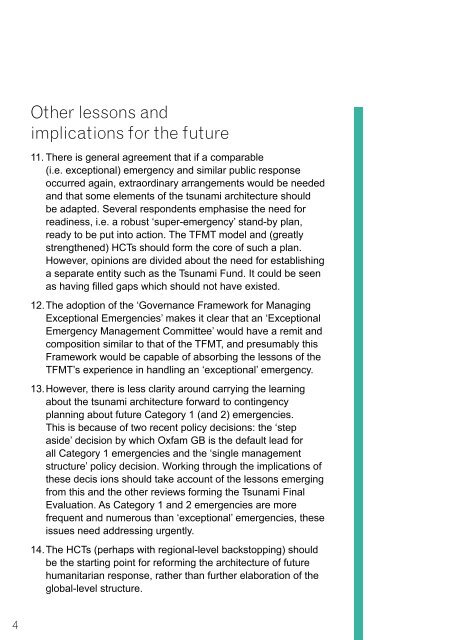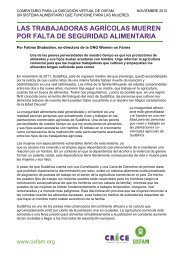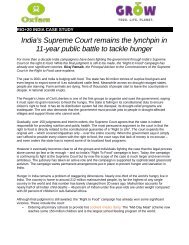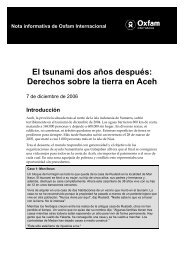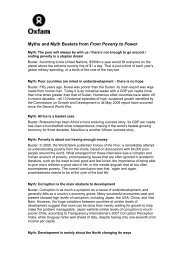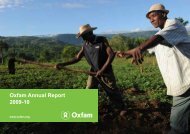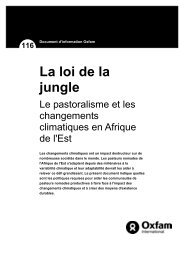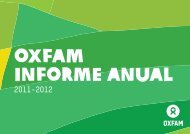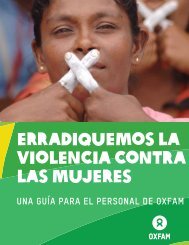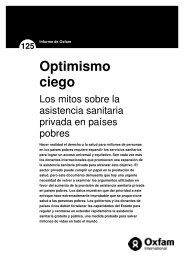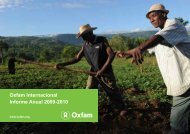Architect. summary report - Oxfam International
Architect. summary report - Oxfam International
Architect. summary report - Oxfam International
You also want an ePaper? Increase the reach of your titles
YUMPU automatically turns print PDFs into web optimized ePapers that Google loves.
Other lessons and<br />
implications for the future<br />
11. There is general agreement that if a comparable<br />
(i.e. exceptional) emergency and similar public response<br />
occurred again, extraordinary arrangements would be needed<br />
and that some elements of the tsunami architecture should<br />
be adapted. Several respondents emphasise the need for<br />
readiness, i.e. a robust ‘super-emergency’ stand-by plan,<br />
ready to be put into action. The TFMT model and (greatly<br />
strengthened) HCTs should form the core of such a plan.<br />
However, opinions are divided about the need for establishing<br />
a separate entity such as the Tsunami Fund. It could be seen<br />
as having filled gaps which should not have existed.<br />
12. The adoption of the ‘Governance Framework for Managing<br />
Exceptional Emergencies’ makes it clear that an ‘Exceptional<br />
Emergency Management Committee’ would have a remit and<br />
composition similar to that of the TFMT, and presumably this<br />
Framework would be capable of absorbing the lessons of the<br />
TFMT’s experience in handling an ‘exceptional’ emergency.<br />
13. However, there is less clarity around carrying the learning<br />
about the tsunami architecture forward to contingency<br />
planning about future Category 1 (and 2) emergencies.<br />
This is because of two recent policy decisions: the ‘step<br />
aside’ decision by which <strong>Oxfam</strong> GB is the default lead for<br />
all Category 1 emergencies and the ‘single management<br />
structure’ policy decision. Working through the implications of<br />
these decis ions should take account of the lessons emerging<br />
from this and the other reviews forming the Tsunami Final<br />
Evaluation. As Category 1 and 2 emergencies are more<br />
frequent and numerous than ‘exceptional’ emergencies, these<br />
issues need addressing urgently.<br />
14. The HCTs (perhaps with regional-level backstopping) should<br />
be the starting point for reforming the architecture of future<br />
humanitarian response, rather than further elaboration of the<br />
global-level structure.<br />
References<br />
i<br />
The ‘architecture’ refers to the Tsunami Fund, governed by the Tsunami Fund<br />
Board (referred to in the <strong>report</strong> as the TF), the Tsunami Fund Management<br />
Team (TFMT), and Humanitarian Country Teams (HCTs).<br />
ii<br />
Throughout the <strong>report</strong>, the term ‘<strong>Oxfam</strong>’ is used to mean the <strong>Oxfam</strong><br />
<strong>International</strong> confederation, and individual affiliates and OI structures are<br />
referred to by name.<br />
4 5


